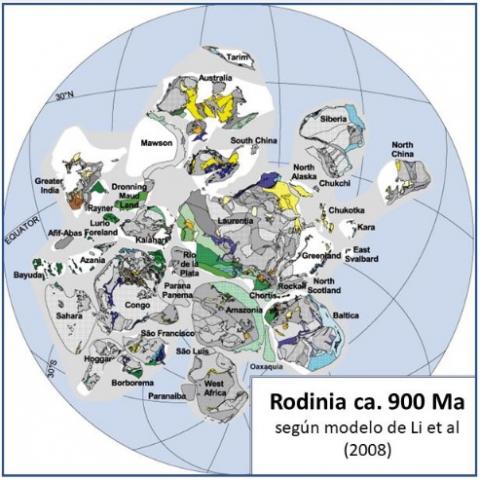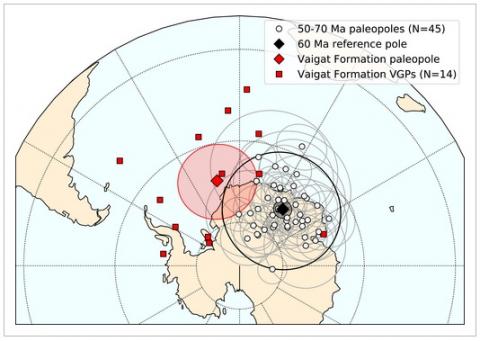Hallazgos paleoindios en el Rio Negro Medio: nuevos aportes de San Gregorio de Polanco, Uruguay
artifacts recently recorded in the San Gregorio de Polanco area (middle Río Negro basin, Uruguay). They allow expanding the database and deepen our knowledge of various aspects of the distribution of Fell points, discoidal stones, and retouched unifacial edge artifacts corresponding to the early regional groups. In addition, the observations presented serve to discuss the similarities of these remains with those found in other places in the Americas.
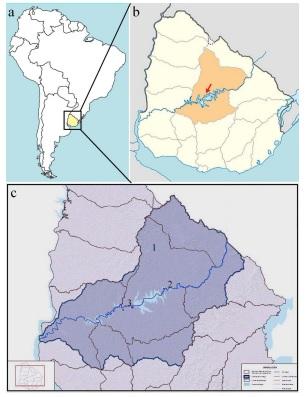
The birth of the Gondwanide arc: Insights into Carboniferous magmatism of the North Patagonian Andes (Argentina)

The hydrocarbon potential of the offshore Talara Basin, Perú
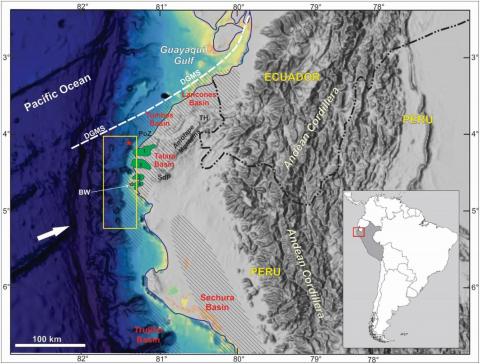
Reconstructing paleoenvironmental and diagenetic dynamics from clay mineral assemblages in the Neogene Fiambalá Basin, NW Argentina
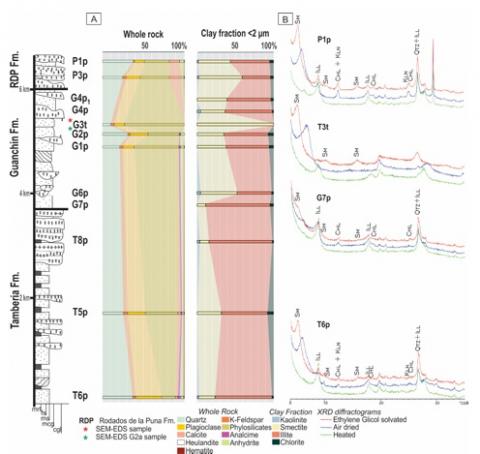
¿Qué edad tiene el Núcleo Interno de la Tierra?

Estructuración y evolución tectónica neoproterozoica-mesozoica del Uruguay mediante la aplicación de métodos geofísicos potenciales, con énfasis en la región central del Cinturón Dom Feliciano
Grado: Tesis Doctoral
Alumno: Pablo Andrés Nuñez Demarco ![]()
Año: 2022
Directora: Dra. Claudia Beatriz Prezzi ![]()
Codirectora: Dra. Leda Sánchez Bettucci
Consejera de Estudios: Dra. María Julia Orgeira ![]()
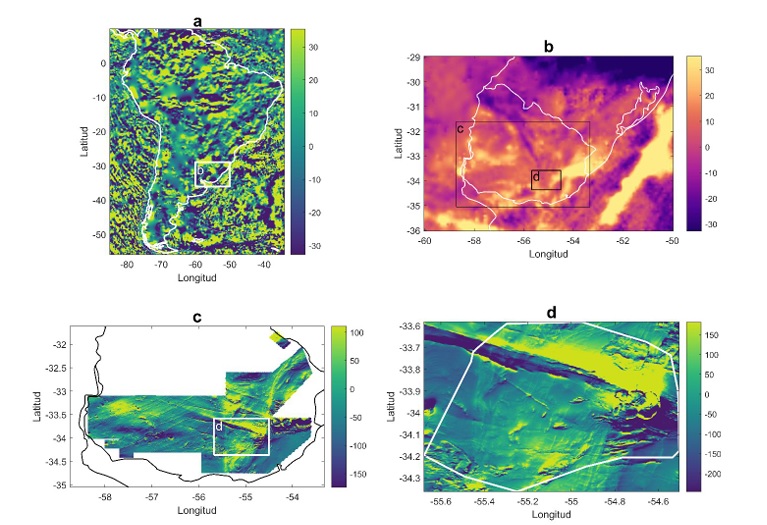
Resumen
El objetivo general de esta tesis es contribuir a la comprensión de la evolución tectónica proterozoica y mesozoica del Uruguay mediante el análisis integrado de relevamientos gravimétricos y magnetométricos terrestres, aéreos y satelitales y de datos geológicos y estructurales. En particular, se hace foco en el estudio de la evolución tectónica de la zona central del basamento cristalino del Uruguay, localizada en el departamento de Lavalleja (-33°40'34° S; -54°40'55°30' O). Dicha zona, donde afloran la Formación Barriga Negra y los intrusivos graníticos de los complejos Polanco y Santa Lucía, comprende los sectores centrales de la cuenca aulacogénica mesozoica y del Cinturón Dom Feliciano y su límite con el Terreno Nico Pérez. En consecuencia, resulta clave para comprender la estructuración y evolución neoproterozoica y mesozoica del escudo uruguayo. Para poder interpretar los datos magnetométricos y gravimétricos de manera rigurosa se llevaron a cabo revisiones detalladas de los diversos métodos y técnicas comúnmente aplicados al análisis de campos potenciales (análisis espectral, deconvolución de Euler, filtros). Estas revisiones llevaron a establecer correcciones e innovaciones metodológicas que permiten realizar simplificaciones en los procesos y obtener una mayor certidumbre en los resultados. En particular, con respecto al análisis espectral se definieron los límites de algunos de los parámetros requeridos para los cálculos de profundidad de fuentes magnéticas, estableciendo nuevos criterios y condiciones más rigurosas para su correcta aplicación. Asimismo, se desarrollaron diversos programas en Matlab y modelos para el testeo de los diversos métodos y técnicas y sus parámetros. A partir de los datos disponibles y de los relevados en el marco de esta tesis se trabajó en tres escalas diferentes. Se realizó una interpretación de gran escala de anomalías magnetométricas correspondientes a modelos globales. Se llevó adelante un estudio de escala regional, a partir de relevamientos aeromagnéticos y gravimétricos de la República Oriental del Uruguay. Finalmente, se trabajó a escala local con datos gravimétricos terrestres relevados en el departamento de Lavalleja, en combinación con nuevo mapeo geológico-estructural. El análisis de modelos globales permitió reevaluar las estructuras y límites del Cratón del Río de la Plata y cuencas suprayacentes. Las interpretaciones de escala regional y local posibilitaron establecer la estructuración paleoproterozoica, neoproterozoica y mesozoica del Uruguay. Se identificaron diversos enjambres de diques máficos paleoproterozoicos y mesozoicos y se determinó el rumbo e inclinación de algunas estructuras, así como su cronología. A partir de la integración de los resultados obtenidos se propone un nuevo modelo para la apertura del rift mesozoico, el cual involucra una zona de transferencia controlada por la reactivación de estructuras correspondientes al cinturón Dom Feliciano.
Abstract
Neoproterozoic-Mesozoic tectonic structuring and evolution of Uruguay through the application of potential geophysical methods, with emphasis on the Dom Feliciano Belt central region. The aim of this thesis is to contribute to the understanding of the Proterozoic and Mesozoic tectonic evolution of the Uruguayan shield through the integrated analysis of gravimetric and magnetometric, land, aerial and satellite surveys; and geological and structural data. In particular, it focuses on the study of the tectonic evolution of the central zone of the crystalline basement of Uruguay, located in the department of Lavalleja (-33°40'34°S; -54°40'55°30 'W). This area, where the Barriga Negra Formation and the granitic intrusions of the Polanco and Santa Lucía complexes crop out, comprises the central sectors of the Mesozoic aulacogenic basins, the Dom Feliciano Belt and its limit with the Nico Pérez Terrain. Consequently, it is key to understanding the Neoproterozoic and Mesozoic structure and evolution of the Uruguayan Shield. In order to interpret the magnetometric and gravimetric data in a rigorous way, detailed reviews of the various methods and techniques commonly applied to the analysis of potential fields (spectral analysis, Euler deconvolution, filters) were carried out. These reviews led to the establishment of corrections and methodological innovations that allowed simplifications in the processes and resulted in a greater certainty of the results. In particular, with regard to spectral analysis, the limits of some of the parameters required for the depth calculations of magnetic sources were defined, establishing new criteria and more rigorous conditions for their correct application. Likewise, various Matlab programs and models were developed for testing the various methods and techniques and their parameters. Based on the available data and those surveyed in the framework of this thesis, analysis and interpretations were carried out on three different scales. A large-scale interpretation of magnetometric anomalies corresponding to global models was performed. A regional scale study was carried out, based on aeromagnetic and gravimetric surveys of Uruguay. Finally, we worked on a local scale with land gravity data collected in the department of Lavalleja, in combination with new geological-structural mapping. The analysis of global models made it possible to re-evaluate the structures and limits of the Río de la Plata Craton and overlying basins. Interpretations on a regional and local scale made it possible to establish the Paleoproterozoic, Neoproterozoic and Mesozoic structure of Uruguay. Various swarms of Paleoproterozoic and Mesozoic mafic dikes were identified and the strike and dip of some structures, as well as their relative chronology, were determined. From the integration of the obtained results, a new model is proposed for the opening of the Mesozoic rift, which involves a transfer zone controlled by the reactivation of structures corresponding to the Neoproterozoic Dom Feliciano Belt.
Caracterización de estructuras del manto superior en la región del extremo norte de la Península Antártica, mediante un análisis de las anomalías de velocidad sísmica
In order to study the seismic structure of the upper mantle underlying the South ridge of Scotia and the northern end of the Antarctic Peninsula, a joint inversion seismic tomography, based on the travel time residuals of the P and S waves, was carried out. It was based on seismographic records acquired continuously at seismological stations located in Argentine Antarctic bases, from the Argentine-Ita-lian Project for the management and maintenance of ASAIN: Antarctic Seismograph Argentinian Italian Network. The signals used correspond to local seismotectonic events of moderate to large magnitude that occurred between 2009 and 2019. The regularization method was implemented for the data discrete inversion. The results were evaluated by synthetic resolution tests. The seismic structures resolved with the tomographies were characterized and interpreted. The study was complemented by estimating the Poisson's modulus and the bulk sound velocity anomaly, which allowed the incorporation of restriction conditions and, therefore, assessment conditions in the interpretation of the tomographies. The presence of a negative S-wave velocity anomaly in the Bransfield basin sector is highlighted, in correspondence with that reported by other authors. It is interpreted as a region of the crust and mantle subjected to modifications of the rheological condition (decrease in rigidity, increase in incompressibility and increase in anelasticity) caused by an anomalous thermal flux from a source located deeper in the mantle.
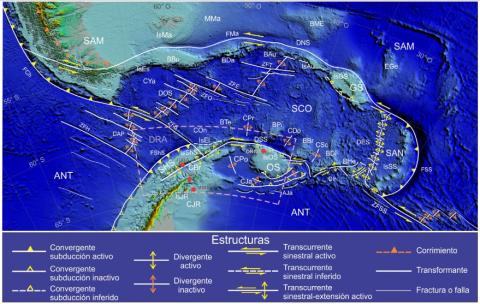
Compositional, thermal, and tectonic contributions to the present-day elevation of the Central Andes and their forearc and foreland regions
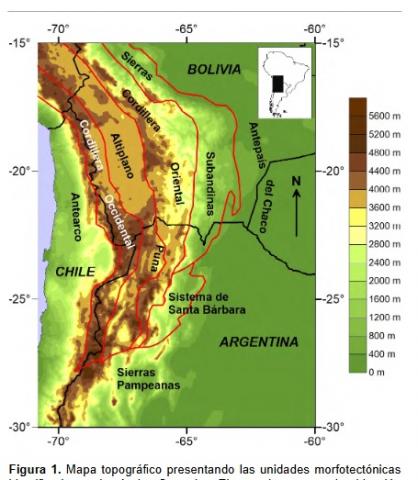
Misterios y rarezas del final del precámbrico: un enfoque paleomagnético
veloces y de cerca de 90° por intercambio de los ejes de inercia del planeta; 6) la posibilidad de que los polos magnéticos estuvieran ubicados durante largos lapsos en el ecuador; 7) un campo magnético ultradébil, con la menor paleointensidad registrada; 8) un campo magnético hiperactivo, con la máxima frecuencia de reversiones de polaridad conocida; 9) el posible inicio de la formación del núcleo interno y el subsecuente cambio en la modalidad de la geodínamo terrestre; entre varios más. A través de estudios paleomagnéticos sistemáticos es posible aportar información muy valiosa para resolver
muchos de estos interrogantes. Desde hace dos décadas, en el Laboratorio de Paleomagnetismo Daniel A. Valencio del IGEBA venimos desarrollando estudios multidisciplinarios sistemáticos en rocas sedimentarias y volcánicas ediacaranas del cratón del Río de la Plata. Estas investigaciones se nutren de una colaboración estrecha y continua con colegas de otros grupos de investigación de Argentina, Brasil y Uruguay. Los estudios incluyen principalmente investigaciones paleomagnéticas con el fin de reconstruir la evolución paleogeográfica del cratón en el Ediacarano y aportar a conocer la cinemática de la formación del Gondwana. Recientemente estamos también avanzando en el conocimiento de las reversiones de polaridad del paleocampo magnético en el Ediacarano tardío. Dataciones geocronológicas precisas, estudios isotópicos sistemáticos y recientes hallazgos fósiles espectaculares, sumados a la información paleomagnética, están aumentando significativamente nuestro conocimiento de un período hasta hace dos décadas casi desconocido. Estos avances incluyen una reconstrucción esquemática de la evolución paleogeográfica del cratón del Río de la Plata entre aproximadamente 600 y 550 Ma, durante el cual el mismo habría migrado desde bajas a altas latitudes. Con esta información y la de otros cratones de Gondwana Occidental están surgiendo restricciones a las edades de anexión con Congo-São Francisco y África Occidental. También permiten especular con mayor sustento observacional sobre la posible existencia (o no) de un gran océano llamado Clymene en etapas finales de formación del Gondwana. El probable registro de la excursión Shuram en sedimentos calcáreos del cratón es una posibilidad concreta a medida que avanzan los estudios quimioestratigráficos. Si bien aún de modo incipiente, los primeros resultados magnetoestratigráficos que estamos obteniendo sugieren la aparente presencia de rápidas reversiones de polaridad. Esta sucesión de nuevos resultados marca límites a ciertos modelos o propuestas no actualistas mientras que es compatible con otros, abriendo un importante número de nuevos interrogantes. En este trabajo se presenta un breve resumen del conocimiento actual a nivel global de muchas de estas controversias, así como del avance de las investigaciones en nuestro país.
